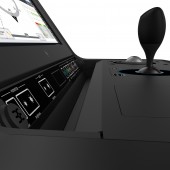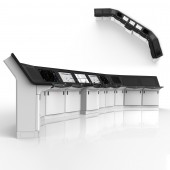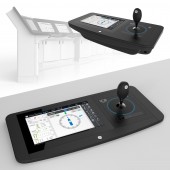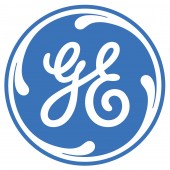GE’s New Bridge Suite Ship Control System by L A Design |
Home > Winners > #33003 |
 |
|
||||
| DESIGN DETAILS | |||||
| DESIGN NAME: GE’s New Bridge Suite PRIMARY FUNCTION: Ship Control System INSPIRATION: GE’s new direction in DP control systems sets new standards of excellence in ship positioning and directly addresses the needs of ship owners, shipbuilders and DP operators. This mariner-friendly package of controls and displays acknowledges the unique skills and high expectations of the mariners, often operating in dangerous or environmentally sensitive locations. This allows them to re-focus on seamanship and ship handling rather than becoming distracted by DP system management. Side-by-side consultation at every level of the industry has guided the development and application of the advanced technology and control techniques, ensuring that the DP systems integrate with and enhance the flexibility of effective maritime operations. The DP system provides a comfortable, reduced-stress working environment enabling the operator to fulfill his duties safely and efficiently. UNIQUE PROPERTIES / PROJECT DESCRIPTION: GE’s new bridge suite of modular consoles integrates positioning technology, engine controls, and navigation equipment into any bridge configuration. From large integrated bridge suites to free standing consoles installed into existing work stations and confined spaces. This allows operating ships to serve new markets without a major refit and new lightweight vessels can install the suite. A movable screen helps eliminate reflections and optimize touch screen ergonomics. All work surfaces are non-reflective with integrated grab handles. OPERATION / FLOW / INTERACTION: The novel introduction of a pivoting screen allows the operator to stand close to the console for comfortable accurate touch control, whilst also gripping the deep edge profiles for support in rough weather. Feedback images from the screen can be transferred to any monitor on an overhead display and viewed from distance. The controlling console in a suite is clearly identified by the color of the badge on the front which helps differentiate its function, as other screens may look similar. Display graphics retain the same appearance in day and night mode for instant recognition. All access for servicing is from the front. PROJECT DURATION AND LOCATION: Started in January 2013 and launched at the OTC Exhibition in the USA in May 2013, pre-production April 2014. FITS BEST INTO CATEGORY: Product Engineering and Technical Design |
PRODUCTION / REALIZATION TECHNOLOGY: The lightweight laser-cut steel construction is galvanized and powder coated to survive in the salty environment. The strength and versatility of the modules appeals to owners and ship yards because it simplifies their specification and installation process. The use of the high resolution touch screen also enables the integration of bespoke ‘soft’ control panels for other purposes to suit specific ships. All the work surfaces are designed to support customer specified instrument and comms equipment. Consoles are designed to IP22 standards for water ingress management and internal protection. SPECIFICATIONS / TECHNICAL PROPERTIES: A single console: Width 700mm x Depth 725mm x Height 1200mm Other modules include: 45° corner 65° corner Extended width 1200mm and 1400mm Extended depth 900mm and 1100mm Chart table with drawers TAGS: Ship Controls, Integrated Bridge, Marine, Touch Screen, Positioning System RESEARCH ABSTRACT: LA have studied the control procedures on cross-channel ferries, Rhine barges and the new generation of fast support vessels used to build and service oil platforms and off shore wind turbines. These ships are often used in confined spaces and rough seas so personal support when standing, accurate intuitive instruction, clear vision of the monitors and feedback data from several positions, are all vital for safety and the completion of the mission. Compliance with strict national and global industry standards like DNV is essential for global sales. CHALLENGE: For the ships commercial viability and safety at sea, GE’s new positioning system needed to be intuitive to control, fast to react and have clear visual feedback. The commercial requirement to manoeuvre ships accurately in confined spaces has led to the development of new positioning technology, engine control systems and monitoring devices. As every command on a ship incurs a complex series of actions to implement, the objective has to be clear and the captain must combine his observation of movement with all the technical data to define ‘position’ accurately. As a result, a clear intuitive user interface which links the instruction to the effect is vital. The introduction of new touch screen technology would also remove the risk of error caused by complex manual control panels. In a marine environment, interacting with a flat sheet of glass in bright sunshine, total darkness or rough seas became a key challenge. The operator needs to support himself, accurately instruct the system then monitor the effect on the ship. ADDED DATE: 2014-02-24 06:25:25 TEAM MEMBERS (7) : Will Bentall (LA Design), Simon Wilkinson (LA Design), Andrew Malloy (LA Design), Chris Bannigan (GE Energy Management), Andy Baker (GE Energy Management), Mike Autherson (GE Energy Management) and Melody Ivory (GE Energy Management) IMAGE CREDITS: LA Design 2014 |
||||
| Visit the following page to learn more: http://www.la-design.co.uk | |||||
| AWARD DETAILS | |
 |
Ge’s New Bridge Suite Ship Control System by L a Design is Winner in Product Engineering and Technical Design Category, 2013 - 2014.· Press Members: Login or Register to request an exclusive interview with L A Design. · Click here to register inorder to view the profile and other works by L A Design. |
| SOCIAL |
| + Add to Likes / Favorites | Send to My Email | Comment | Testimonials | View Press-Release | Press Kit | Translations |







